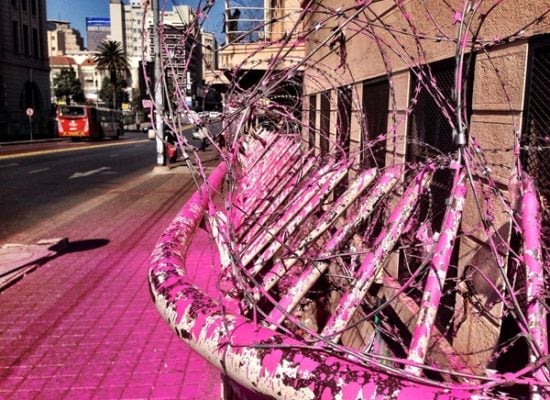During the past few summer months, residents of Johannesburg have been noticing a strange phenomenon: a growing number of abandoned buildings in the City’s central business district sporting large splotches of neon pink paint streaming down from roofs or streaked underneath open windows, making it appear as if many of these empty buildings are leaking or “bleeding” color.
More recently, Columbian-born, New York–based multimedia artist Yazmany Arboleda, who holds a master’s degree in architecture, has stepped into the limelight as the organizer of the project, which is entitled “Beware of Colour.” Arboleda hopes to bring attention to the problem of scores of abandoned buildings in downtown Johannesburg and the numerous social and economic problems they have spawned, such as the fact of squatters forced to pay rent to illegimate “landlords” for housing that has no electricity or running water.
Arboleda recruited roughly 30 Johannesburg artists who ventured out between 1 and 5 a.m. each morning to mark the buildings. “Buildings which were once derelict and abandoned despite an overwhelming housing shortage and crisis are drawing attention to themselves in hot flashes of pink, as once loved but now discarded works of art,” according to his statement about the project.
Arboleda, who purposely chose water soluble paint (and points out that it can be easily washed off should owners care to do so), described some of the challenges of executing the project, such as the need to focus on confirmed empty buildings so as not to become advertisements for squatters—and spark possible evictions (He chronicled the overall experience in a detailed post on the blog Voices of Africa). He also has helped maintain the anonymity of artists who wanted to participate but feared reprisal.
On one occasion, after a building security director called the police, Arboleda said he directed his fellow, paint-splattered colleagues to leave the scene. In an email to artnet News, he described what happened next: “I willingly went to the police precinct to explain the project to the colonel, as the police officers who came to the site requested. Once there I indeed have no ID or cell phone. Because of this the colonel felt that he could not let me go and held me with a charge of “malicious damage to property.” I was released on bail the following day and brought to court where the charges were dropped (a day later) because the judge and prosecutor agreed that the charge would not hold up in court—you cannot damage a property that is already in such disrepair.”
In some instances, the local artists, aware of just how dangerous these darkened, crime-ridden buildings are, were reluctant to set foot inside. As Arboleda described it: “The big challenge with most of our buildings is gaining entry to the second floor—once inside, we usually have access to the rest of the building. We walk up to the roof, and prepare our tools, pouring the pink paint slowly and evenly from top to bottom. As much work as could be done in preparation, we never have control over how the paint will actually adhere to each building. The speed and texture always varies, and it is always exciting to gaze upon the end result the following morning.”
Asked about the various roadblocks, Arboleda says he considers everything that happens as part of the project to be art. “I strongly believe that the local artists own as much of this project as I do,” he told artnet News.
During a recent interview in New York, the ebullient Arboleda explained the purpose of this and other projects he has organized, such as handing out 10,000 biodegradable balloons in Kabul. These actions, he says, are designed “to engage communities in a process of reinvention through art. Using our collective imagination, we orchestrate interventions that transform public spaces.”
Responding to critics of the Johannesburg project, Arboleda points out his background as an architecture scholar, noting, “I care deeply about the buildings and the urban environment, and this is part of why we did the project to begin with.” People don’t seem to realize, he said, that “unfortunately the city is/was planning to demolish some of these historic buildings anyway, to turn them into parking lots. If my work generates a debate, then I feel that shows that it is having an impact. Engaging the community and prompting reactions is a part of the process.”
